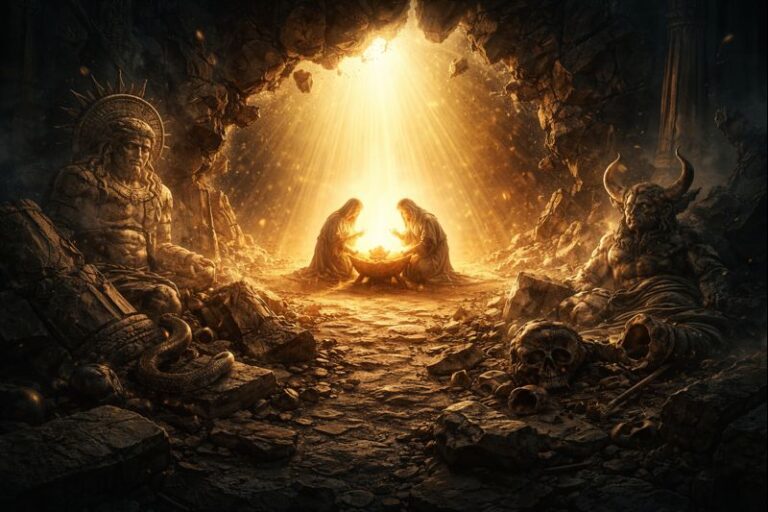
The passage in 1 Thessalonians 4:13-17 is one of the most frequently cited texts in support of the Pre-Tribulation Rapture, a theological concept asserting that Christ will return secretly to take believers from the earth before a period of tribulation. However, a closer examination of the text within its biblical and historical context strongly supports the interpretation that Paul is speaking of the Second Coming of Christ, not a secret, pre-tribulation event. This article will explore the language, themes, and eschatological framework of the passage to demonstrate its connection to the Second Coming.
The Context of the Passage
The Thessalonians were deeply concerned about the fate of their loved ones who had passed away. They feared that those who had died might miss out on the blessings of Christ’s return. This concern is evident in Paul’s opening statement:
“But we do not want you to be uninformed, brothers, about those who are asleep, that you may not grieve as others do who have no hope” (1 Thessalonians 4:13).
In addition, the Thessalonians also wondered about the fate of those who would still be alive when Christ returned. Paul addresses these concerns with pastoral reassurance, emphasizing the unity of all believers—living and dead—at the Second Coming of Christ.
Key Arguments for the Second Coming
The Description of Christ’s Return
Paul describes Christ’s coming with vivid and unmistakable imagery:
- “The Lord Himself will descend from heaven”: This is an echo of Acts 1:11, where the angels declare that Jesus will return “in the same way” as He ascended—visible and bodily.
- “With a cry of command, with the voice of an archangel, and with the sound of the trumpet of God”: These elements point to a dramatic, public event, not a secret occurrence. The trumpet, in particular, is a consistent biblical symbol of divine intervention and judgment, as seen in Matthew 24:31 and 1 Corinthians 15:52, both of which are associated with the Second Coming.
Parallels to Matthew 24
The sequence of events in 1 Thessalonians 4 closely mirrors Jesus’ description of His return in Matthew 24:29-31:
- “The Son of Man coming on the clouds” aligns with believers being “caught up together with them in the clouds.”
- Both passages mention a trumpet call and a gathering of the elect.
The Phrase “Caught Up” (Harpazo)
The term harpazo (“caught up”) does not necessitate a secret rapture but instead signifies being taken up to meet the Lord as He descends. This imagery aligns with the ancient custom of citizens going out to greet a visiting dignitary and escorting them into their city—a practice known as a parousia. This reinforces the idea that believers meet Christ to accompany Him as He descends to establish His kingdom.
Paul’s Assurance to the Thessalonians
Paul’s explanation directly addresses the Thessalonians’ concerns:
- What happens to believers who have died?
Paul assures them that those who have “fallen asleep” (died) will not miss out. Instead, they will rise first when Christ returns:
“The dead in Christ will rise first” (v. 16). - What happens to believers who are still alive?
Those who are alive at Christ’s coming will not precede the dead but will join them:
“We who are alive, who are left, will be caught up together with them in the clouds to meet the Lord in the air” (v. 17).
This sequence emphasizes the unity of all believers at the Second Coming, whether living or dead. The imagery is not one of escape but of joyful reunion and participation in Christ’s triumphant return.
The Focus on the Resurrection
Paul emphasizes the resurrection of the dead in Christ, stating they will rise first, followed by those who are alive. This resurrection theme is inseparable from the Second Coming in biblical eschatology:
- 1 Corinthians 15:52 connects the resurrection of the dead to the “last trumpet,” clearly associated with the Second Coming.
- Nowhere does Scripture separate the resurrection of believers from Christ’s visible return.
Absence of Pre-Tribulation Themes
The passage contains no mention of:
- A tribulation period before or after the described event.
- A distinction between two phases of Christ’s coming (a secret rapture and a visible Second Coming).
- Believers being removed to escape tribulation.
Instead, the focus is on comforting believers about their deceased loved ones, assuring them that they will be reunited at Christ’s return.
Reassurance and Comfort
Paul concludes the passage with the words:
“Therefore encourage one another with these words” (1 Thessalonians 4:18).
This underscores his intent to provide comfort. The Thessalonians were grieving and anxious, and Paul assures them that:
- The dead in Christ will rise.
- The living will join them in the air.
- All believers will be together with the Lord forever.
These assurances are grounded in the hope of the Second Coming, not in the idea of a secret rapture. By placing the focus on the ultimate unity and victory of believers, Paul reinforces the certainty and public nature of Christ’s return.
Conclusion
The Thessalonians’ questions about the fate of the living and the dead at Christ’s return are central to understanding 1 Thessalonians 4:13-17. Paul’s response, far from teaching a pre-tribulation rapture, is a comforting explanation of the Second Coming, where all believers—whether living or dead—will be united in Christ’s presence. Recognizing this context clarifies the passage’s meaning and reinforces its connection to the broader biblical narrative of Christ’s glorious return.
This understanding not only aligns with the rest of Scripture but also strengthens the hope and anticipation of Christ’s ultimate victory over death and His eternal reign with His people.
Discussion Questions
- How does the imagery and language in 1 Thessalonians 4:13-17 support the view that it describes the Second Coming rather than a secret rapture?
- In what ways does Paul’s explanation of the resurrection of the dead challenge the idea of a pre-tribulation rapture?
- How does the cultural and pastoral context of the Thessalonians’ concerns influence the interpretation of this passage?




